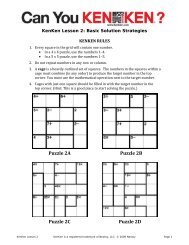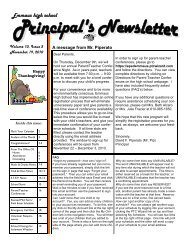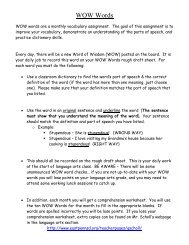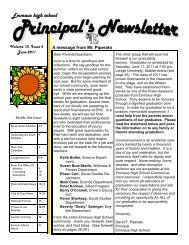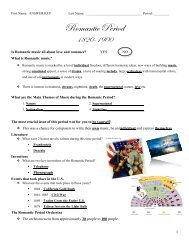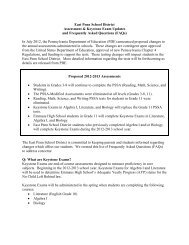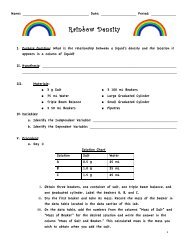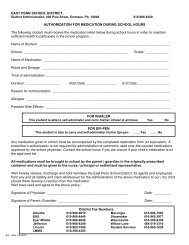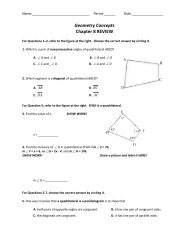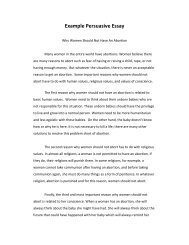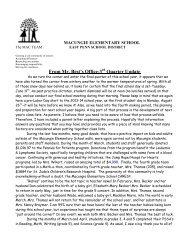Chapter 4 Trigonometric Functions
Chapter 4 Trigonometric Functions
Chapter 4 Trigonometric Functions
You also want an ePaper? Increase the reach of your titles
YUMPU automatically turns print PDFs into web optimized ePapers that Google loves.
<strong>Trigonometric</strong> <strong>Functions</strong><br />
29. Because the tangent is negative and the sine is<br />
positive, θ lies in quadrant II. In quadrant II, x is<br />
negative and y is positive. Thus,<br />
2 y 2<br />
tan θ = − = = , x = − 3, y = 2. Furthermore,<br />
3 x −3<br />
r x y<br />
2 2 2 2<br />
= + = − + = + =<br />
( 3) 2 9 4 13<br />
Now that we know x, y, and r, we can find the<br />
remaining trigonometric functions of θ .<br />
y 2 2 13 2 13<br />
sinθ<br />
= = = ⋅ =<br />
r 13 13 13 13<br />
x −3 −3 13 3 13<br />
cosθ<br />
= = = ⋅ = −<br />
r 13 13 13 13<br />
r 13<br />
cscθ<br />
= =<br />
y 2<br />
r 13 13<br />
secθ<br />
= = = −<br />
x −3 3<br />
x −3 3<br />
cotθ<br />
= = = −<br />
y 2 2<br />
30. Because the tangent is negative and the sine is<br />
positive, θ lies in quadrant II. In quadrant II, x is<br />
negative and y is positive. Thus,<br />
1 y 1<br />
tan θ =− = = , y = 1, x =−3<br />
. Furthermore,<br />
3 x −3<br />
r x y<br />
2 2 2 2<br />
= + = − + = + =<br />
( 3) 1 9 1 10<br />
Now that we know x, y, and r, we can find the<br />
remaining trigonometric functions of θ .<br />
y 1 1 10 10<br />
sinθ<br />
= = = ⋅ =<br />
r 10 10 10 10<br />
x −3 −3 10 3 10<br />
cosθ<br />
= = = ⋅ = −<br />
r 10 10 10 10<br />
r 10<br />
cscθ<br />
= = = 10<br />
y 1<br />
r 10 10<br />
secθ<br />
= = = −<br />
x −3 3<br />
x −3<br />
cotθ<br />
= = =−3<br />
y 1<br />
31. Because the tangent is positive and the cosine is<br />
negative, θ lies in quadrant III. In quadrant III, x is<br />
4 y −4<br />
negative and y is negative. Thus, tan θ = = = ,<br />
3 x − 3<br />
x = –3, y = –4. Furthermore,<br />
2 2 2 2<br />
r = x + y = ( − 3) + ( − 4) = 9+<br />
16<br />
= 25 = 5<br />
Now that we know x, y, and r, we can find the<br />
remaining trigonometric functions of θ .<br />
y −4 4<br />
sinθ<br />
= = = −<br />
r 5 5<br />
x −3 3<br />
cosθ<br />
= = =−<br />
r 5 5<br />
r 5 5<br />
cscθ<br />
= = = −<br />
y −4 4<br />
r 5 5<br />
secθ<br />
= = = −<br />
x −3 3<br />
x −3 3<br />
cotθ<br />
= = =<br />
y −4 4<br />
32. Because the tangent is positive and the cosine is<br />
negative, θ lies in quadrant III. In quadrant III, x is<br />
negative and y is negative. Thus,<br />
5 y −5<br />
tan θ = = = , x =− 12, y =−5<br />
. Furthermore,<br />
12 x −12<br />
2 2 2 2<br />
r = x + y = ( − 12) + ( − 5) = 144+<br />
25<br />
= 169 = 13<br />
Now that we know x, y, and r, we can find the<br />
remaining trigonometric functions of θ .<br />
y −5 5<br />
sinθ<br />
= = =−<br />
r 13 13<br />
x −12 12<br />
cosθ<br />
= = = −<br />
r 13 13<br />
r 13 13<br />
cscθ<br />
= = = −<br />
y −5 5<br />
r 13 13<br />
secθ<br />
= = = −<br />
x −12 12<br />
x −12 12<br />
cotθ<br />
= = =<br />
y −5 5<br />
524<br />
Copyright © 2010 Pearson Education, Inc. Publishing as Prentice Hall.



